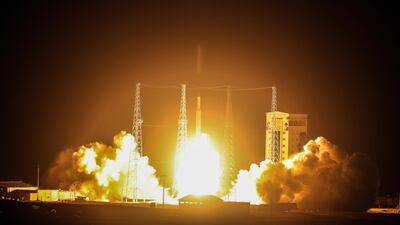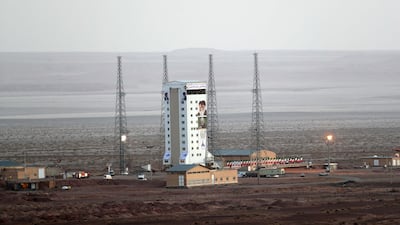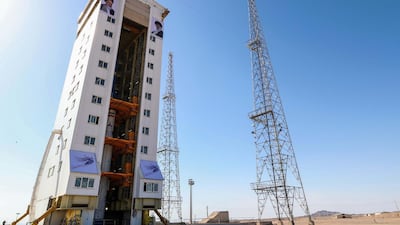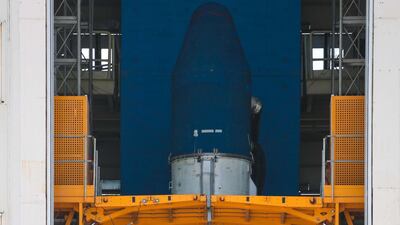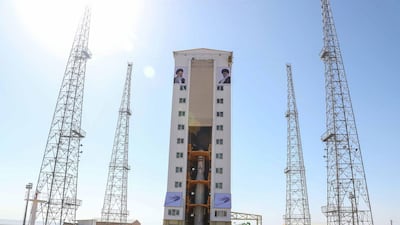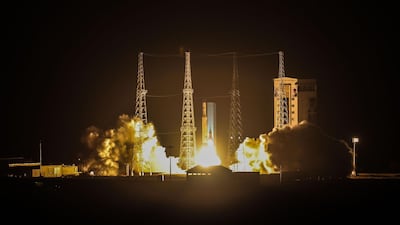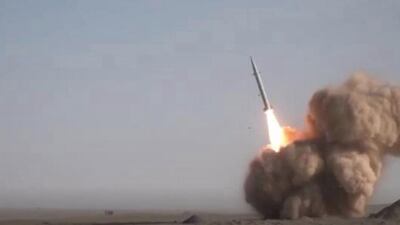Iran’s satellite launchers could be “easily modified” into ballistic missiles following the first successful mission of a military orbiter, an international think tank has warned.
The chief of the Islamic Revolutionary Guard Corps has also claimed that the first launch of a military satellite takes the country’s spying capabilities to the "next level".
His words come as the IRGC seeks use the success to boost its influence in Iran’s internal power struggle after the government suffered criticism for its handling of the coronavirus crisis.
A reconfigured Satellite Launch Vehicle (SLV), using solid-fuel motors of a Sejil medium range missile, could send a rocket armed with a 1,000kg payload for a distance of 2,500km, according to a report by the International Institute of Strategic Studies. The range would bring much of central Europe within range as well as large parts of China and all India.
Solid fuel motors also posed much more of a threat, the report warned. “Herein lies an emerging concern about the IRGC’s nascent space programme. Solid-fuel motors are more compact than their liquid-fuel counterparts. They are also simpler to deploy, transport and launch.”
The solid-fuel systems were not only the military’s preferred choice for ballistic missiles but also demonstrated that the launch vehicles could be “more easily modified for use as a ballistic missile”.
Although no other military has yet turned a liquid-fuel SLV into a ballistic rocket, both Israel and India have converted solid-fuel launchers into missiles.
“Iran could do the same over the next five to ten years if the IRGC space programme continues unabated,” said the report author Mike Elleman, IISS Director of Non-Proliferation and Nuclear Policy Programme.
To prevent Iran developing an intercontinental range missile which would bring America within range, a deal is urgently needed to be negotiated for satellite launches.
"To reduce the risk of the Islamic Republic from developing an intercontinental-range missile capability under the guise of space-launch activities, the international community must negotiate a compromise that permits Iran to launch satellites for peaceful purposes, but prohibits the use of solid-fuel motors larger than the Sejil's first stage," the report stated.
The successful mission marked the first time Iran’s military has carried out a satellite launch. All previous attempts were made by the civilian space arm, the Iranian Space Agency, which suffered a series of mishaps. The military satellite is currently orbiting 440km above the Earth.
Following the April 22 launch, the Guard’s commander-in-chief, Major General Hossein Salami, said it was “a strategic achievement” that took Iran’s defence and information gathering capabilities to the next level.
The officer, who regularly targets America, Israel and Saudi Arabia in aggressive speeches, said it was a new step in Iran’s quest to enhance its regional and global power.
The IISS confirmed the launch was a “powerful message of defiance” to the US and Gulf States particularly at a time when Iran was apparently suffering from very low oil prices and the assassination of the Quds Force leader Qassem Suleimani in January.
Europe’s rearming plan
- Suspend strict budget rules to allow member countries to step up defence spending
- Create new "instrument" providing €150 billion of loans to member countries for defence investment
- Use the existing EU budget to direct more funds towards defence-related investment
- Engage the bloc's European Investment Bank to drop limits on lending to defence firms
- Create a savings and investments union to help companies access capital
Aquaman%20and%20the%20Lost%20Kingdom
%3Cp%3E%3Cstrong%3EDirector%3A%3C%2Fstrong%3E%20James%20Wan%3C%2Fp%3E%0A%3Cp%3E%3Cstrong%3EStarring%3A%3C%2Fstrong%3E%20Jason%20Mamoa%2C%20Patrick%20Wilson%2C%20Amber%20Heard%2C%20Yahya%20Abdul-Mateen%20II%C2%A0%3C%2Fp%3E%0A%3Cp%3E%3Cstrong%3ERating%3A%3C%2Fstrong%3E%202%2F5%3C%2Fp%3E%0A
Heather, the Totality
Matthew Weiner,
Canongate
UAE currency: the story behind the money in your pockets
Cultural fiesta
What: The Al Burda Festival
When: November 14 (from 10am)
Where: Warehouse421, Abu Dhabi
The Al Burda Festival is a celebration of Islamic art and culture, featuring talks, performances and exhibitions. Organised by the Ministry of Culture and Knowledge Development, this one-day event opens with a session on the future of Islamic art. With this in mind, it is followed by a number of workshops and “masterclass” sessions in everything from calligraphy and typography to geometry and the origins of Islamic design. There will also be discussions on subjects including ‘Who is the Audience for Islamic Art?’ and ‘New Markets for Islamic Design.’ A live performance from Kuwaiti guitarist Yousif Yaseen should be one of the highlights of the day.
The%20Super%20Mario%20Bros%20Movie
%3Cp%3E%3Cstrong%3EDirectors%3A%3C%2Fstrong%3E%20Aaron%20Horvath%20and%20Michael%20Jelenic%0D%3Cbr%3E%3Cstrong%3EStars%3A%3C%2Fstrong%3E%20Chris%20Pratt%2C%20Anya%20Taylor-Joy%2C%20Charlie%20Day%2C%20Jack%20Black%2C%20Seth%20Rogen%20and%20Keegan-Michael%20Key%0D%3Cbr%3E%3Cstrong%3ERating%3A%3C%2Fstrong%3E%201%2F5%3C%2Fp%3E%0A
COMPANY%20PROFILE
%3Cp%3E%3Cstrong%3EName%3A%20%3C%2Fstrong%3ESmartCrowd%0D%3Cbr%3E%3Cstrong%3EStarted%3A%20%3C%2Fstrong%3E2018%0D%3Cbr%3E%3Cstrong%3EFounder%3A%20%3C%2Fstrong%3ESiddiq%20Farid%20and%20Musfique%20Ahmed%0D%3Cbr%3E%3Cstrong%3EBased%3A%20%3C%2Fstrong%3EDubai%0D%3Cbr%3E%3Cstrong%3ESector%3A%20%3C%2Fstrong%3EFinTech%20%2F%20PropTech%0D%3Cbr%3E%3Cstrong%3EInitial%20investment%3A%20%3C%2Fstrong%3E%24650%2C000%0D%3Cbr%3E%3Cstrong%3ECurrent%20number%20of%20staff%3A%3C%2Fstrong%3E%2035%0D%3Cbr%3E%3Cstrong%3EInvestment%20stage%3A%20%3C%2Fstrong%3ESeries%20A%0D%3Cbr%3E%3Cstrong%3EInvestors%3A%20%3C%2Fstrong%3EVarious%20institutional%20investors%20and%20notable%20angel%20investors%20(500%20MENA%2C%20Shurooq%2C%20Mada%2C%20Seedstar%2C%20Tricap)%3C%2Fp%3E%0A
TO A LAND UNKNOWN
Director: Mahdi Fleifel
Starring: Mahmoud Bakri, Aram Sabbah, Mohammad Alsurafa
Rating: 4.5/5
Other acts on the Jazz Garden bill
Sharrie Williams
The American singer is hugely respected in blues circles due to her passionate vocals and songwriting. Born and raised in Michigan, Williams began recording and touring as a teenage gospel singer. Her career took off with the blues band The Wiseguys. Such was the acclaim of their live shows that they toured throughout Europe and in Africa. As a solo artist, Williams has also collaborated with the likes of the late Dizzy Gillespie, Van Morrison and Mavis Staples.
Lin Rountree
An accomplished smooth jazz artist who blends his chilled approach with R‘n’B. Trained at the Duke Ellington School of the Arts in Washington, DC, Rountree formed his own band in 2004. He has also recorded with the likes of Kem, Dwele and Conya Doss. He comes to Dubai on the back of his new single Pass The Groove, from his forthcoming 2018 album Stronger Still, which may follow his five previous solo albums in cracking the top 10 of the US jazz charts.
Anita Williams
Dubai-based singer Anita Williams will open the night with a set of covers and swing, jazz and blues standards that made her an in-demand singer across the emirate. The Irish singer has been performing in Dubai since 2008 at venues such as MusicHall and Voda Bar. Her Jazz Garden appearance is career highlight as she will use the event to perform the original song Big Blue Eyes, the single from her debut solo album, due for release soon.
The specs
Engine: 8.0-litre, quad-turbo 16-cylinder
Transmission: 7-speed auto
0-100kmh 2.3 seconds
0-200kmh 5.5 seconds
0-300kmh 11.6 seconds
Power: 1500hp
Torque: 1600Nm
Price: Dh13,400,000
On sale: now
In numbers: China in Dubai
The number of Chinese people living in Dubai: An estimated 200,000
Number of Chinese people in International City: Almost 50,000
Daily visitors to Dragon Mart in 2018/19: 120,000
Daily visitors to Dragon Mart in 2010: 20,000
Percentage increase in visitors in eight years: 500 per cent
The specs: 2018 Mercedes-Benz E 300 Cabriolet
Price, base / as tested: Dh275,250 / Dh328,465
Engine: 2.0-litre four-cylinder
Power: 245hp @ 5,500rpm
Torque: 370Nm @ 1,300rpm
Transmission: Nine-speed automatic
Fuel consumption, combined: 7.0L / 100km
UAE squad
Esha Oza (captain), Al Maseera Jahangir, Emily Thomas, Heena Hotchandani, Indhuja Nandakumar, Katie Thompson, Lavanya Keny, Mehak Thakur, Michelle Botha, Rinitha Rajith, Samaira Dharnidharka, Siya Gokhale, Sashikala Silva, Suraksha Kotte, Theertha Satish (wicketkeeper) Udeni Kuruppuarachchige, Vaishnave Mahesh.
UAE tour of Zimbabwe
All matches in Bulawayo
Friday, Sept 26 – First ODI
Sunday, Sept 28 – Second ODI
Tuesday, Sept 30 – Third ODI
Thursday, Oct 2 – Fourth ODI
Sunday, Oct 5 – First T20I
Monday, Oct 6 – Second T20I
Specs
Engine: 51.5kW electric motor
Range: 400km
Power: 134bhp
Torque: 175Nm
Price: From Dh98,800
Available: Now
Specs
Engine: Electric motor generating 54.2kWh (Cooper SE and Aceman SE), 64.6kW (Countryman All4 SE)
Power: 218hp (Cooper and Aceman), 313hp (Countryman)
Torque: 330Nm (Cooper and Aceman), 494Nm (Countryman)
On sale: Now
Price: From Dh158,000 (Cooper), Dh168,000 (Aceman), Dh190,000 (Countryman)
French business
France has organised a delegation of leading businesses to travel to Syria. The group was led by French shipping giant CMA CGM, which struck a 30-year contract in May with the Syrian government to develop and run Latakia port. Also present were water and waste management company Suez, defence multinational Thales, and Ellipse Group, which is currently looking into rehabilitating Syrian hospitals.
Killing of Qassem Suleimani
Killing of Qassem Suleimani
More from Neighbourhood Watch:
The specs
Price, base: Dh228,000 / Dh232,000 (est)
Engine: 5.7-litre Hemi V8
Transmission: Eight-speed automatic
Power: 395hp @ 5,600rpm
Torque: 552Nm
Fuel economy, combined: 12.5L / 100km
F1 The Movie
Starring: Brad Pitt, Damson Idris, Kerry Condon, Javier Bardem
Director: Joseph Kosinski
Rating: 4/5
